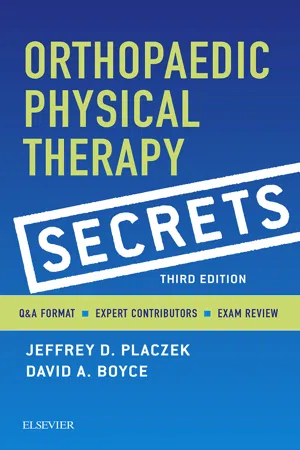
- 704 pages
- English
- ePUB (mobile friendly)
- Available on iOS & Android
Orthopaedic Physical Therapy Secrets - E-Book
About This Book
Whether you're preparing for the OCS or just want to brush up on your orthopedic knowledge, you don't want to be without Placzek and Boyce's new third edition of Orthopaedic Physical Therapy SECRETS. As with previous editions, SECRETS covers a variety of different physical therapy concepts, healing modalities, specialties, and orthopedic procedures to ensure you are well-prepared to pass the OCS and provide the best orthopedic therapy options for today's patients. Common diseases are included as well as more innovative diagnostic tools. Each chapter features thoroughly updated content that's entirely evidence-based and outcome-based. This ebook also features insightful anecdotes — including clinical tips, memory aids, and secrets — and helpful review tools — such as bulleted lists, algorithms and illustrations — to help you thoroughly master all aspects of orthopedic physical therapy practice.
- Coverage of topics found on the orthopedic specialty exam makes this a useful review resource for those studying for the exam.
- Clinical tips provide insightful guidance on a variety of clinical situations and tasks.
- Charts, tables, and algorithims simplify information into logical frameworks.
- Evidence-based content supports the latest orthopedic research.
- Strong chapter on the shoulder and hand succinctly presents important information on this complex topic.
- Annotated references provide a useful tool for research.
- NEW! Completely updated content reflects the latest physical therapy guidelines.
- NEW! Electronic-only format makes this study tool completely portable and accessible on a variety of devices such as the Kindle, Nook, iPad, and more.
Frequently asked questions
Information
Stretching
1 What is stress relaxation?
2 Define creep.
3 When stretching a muscle joint complex, what structures are influenced?
4 What is ballistic (dynamic) stretching?
5 Define static stretching.
6 Describe some commonly used proprioceptive neuromuscular facilitation (or active inhibition) stretching techniques.
7 What is the optimal number of static stretch repetitions?
8 What is the optimal amount of time that a static stretch should be held?
9 What is the optimal intensity of a static stretch?
10 How often must static stretching be performed to maintain gains experienced during a static stretch session?
11 If an individual statically stretches on a regular basis, how long will the gains be retained?
12 Does static muscle stretching alter performance?
Table of contents
- Cover image
- Title page
- Table of Contents
- Copyright
- Dedication
- Contributors
- Preface
- Section I: Basic Science
- Section II: Disease Processes
- Section III: Electrotherapy and Modalities
- Section IV: Special Topics
- Section V: The Shoulder
- Section VI: The Elbow and Forearm
- Section VII: The Wrist and Hand
- Section VIII: The Spine
- Section IX: The Sacroiliac Joint
- Section X: The Hip and Pelvis
- Section XI: The Knee
- Section XII: The Foot and Ankle
- Answers to Study Questions
- Index